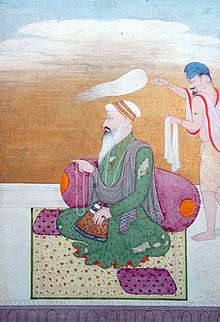Guru Ram Das
| Guru Ram Das ਗੁਰੂ ਰਾਮਦਾਸ | |
|---|---|
 Opaque watercolour on paper c 1800 Government Museum, Chandigarh | |
| Born |
Bhai Jetha 9 October 1534 Chuna Mandi, Lahore, Punjab, Mughal Empire (Present day Pakistan) |
| Died |
September 1, 1581 (aged 46) Goindval, Mughal Empire (Present day India) |
| Other names | The Fourth Master |
| Occupation | Guru |
| Years active | 1574–1581 |
| Known for | Founded the city of Amritsar, composed the hymns of Anand Karaj |
| Predecessor | Guru Amar Das |
| Successor | Guru Arjan |
| Spouse(s) | Bibi Bhani |
| Children | Baba Prithi Chand, Baba Mahan Dev, and Guru Arjan |
| Parent(s) | Hari Das and Mata Anup Devi |
Guru Ram Das ([ɡʊru ɾɑm dɑs]; 1534–1581) was the fourth of the Ten Gurus of Sikhism and was given the title of Sikh Guru on 30 August 1574. He was Guru for seven years. Guru Ram Das was born in Chuna Mandi Lahore, Punjab on 24 September 1534. His father was Hari Das and his mother Anup Devi(Daya Kaur). His wife was Bibi Bhani, the younger daughter of Guru Amar Das. They had three sons: Prithi Chand, Mahadev and Guru Arjan.
His father-in-law, Guru Amar Das, was third of the Ten Gurus. Guru Ram Das became guru on 1 September and was guru for 7 years.
Contributions
As a Guru, one of his main contributions to Sikhism was organizing the structure of Sikh society. Additionally, he was the author of Laava, the four hymns of the Sikh Marriage Rites. He was planner and creator of the township of Ramdaspur which became the Sikh holy city of Amritsar. He founded it in 1574 on land he bought for 700 rupees from the owners of the village of Tung. Earlier Guru Ram Das had begun building Santokhsar Sarovar, near the village of Sultanwind in 1564 (according to one source in 1570). It could not be completed before 1588. In 1574, Guru Ram Das built his residence and moved to the new place. At that time, it was known as Guru Da Chakk. (Later, it came to be known as Chakk Ram Das). In Amritsar, he designed the gurdwara Harmandir Sahib, which translates as "The Abode of God" also known as the Darbaar sahib.
There are 688 Hymns by Guru Ram Das which have various teachings for Sikhs—that are in the Guru Granth Sahib, the Sikh supreme granth
- one of which can be found on page 305 as follows
| “ | One who calls himself a Sikh of the True Guru shall get up early morning and meditate on the Lord's Name. Make effort regularly to cleanse, bathe and dip in the ambrosial pool. Upon Guru's instructions, chant Har, Har singing which, all misdeeds, sins and pains shall go away. | ” |
— Bani of Guru Ram Das Guruf on Sadhu People and Pilgrimage Bath.
Guru's Bani is also part of Nanakshahi calendar and Kirtan Sohila, the daily prayers of Sikhs.
Anand Karaj: Sikh marriage ceremony
The standard Sikh marriage ceremony known as the Anand Karaj is centered on a four-stanza hymn composed by Guru Ram Das. During the marriage ceremony the couple circumscribe the Guru Granth Sahib as each stanza of the Lawan is read. The first round is the Divine consent for commencing the householders life through marriage. The second round states that the union of the couple has been brought about by God. In the third round the couple is described as the most fortunate as they have sung the praises of the Lord in the company of saints. In the fourth round the feeling of the couple that they have obtained their hearts' desire and are being congratulated is described.
'Laavan'
Guru Ram Das composed a beautiful bani called Laavan about the meaning of marriage to a Sikh couple. Effectively, the Guru defines a Sikh marriage as a spiritual union in these two lines: "They are not said to be husband and wife who merely sit together. Rather they alone are called husband and wife, who have one soul in two bodies."
Death
Guru Ram Das died on 1 September 1581, in the city of Amritsar, Punjab.
References
External links
- DiscoverSikhism - Sri Guru Ram Das Ji Sri Guru Ram Das Ji is the fourth of the Ten Sikh Gurus.
- Sikhs.org
- Sikh-History.com
- scys-online.org
- SGRDIDSR
- GRD Academy
| Preceded by Guru Amar Das |
Sikh Guru 1 September 1574 – 1 September 1581 |
Succeeded by Guru Arjan |
